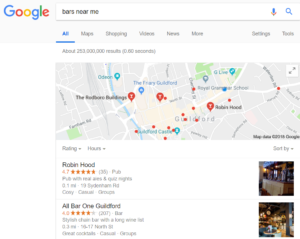Estimated Reading Time [est_time]
Are we procrastinating our plans because we know we can get away with it?
Introduction to ‘near me’
If 4 out of 5 people in the UK have a mobile phone, we can assume that our mobile habits are regularly changing aligned with updates in technology. There has been a huge change in the way we are searching for restaurants/shops/bars etc. It has never been easier to organise a quick drink after work. Simply type into Google, ‘bars near me’, and this is what you will be fronted with:
Before you know it, you will have a gin & tonic in your hand. Google answers your ‘near me’ question with a radius of bars near you.
You have probably thought ‘how does Google know what is near me?
Through exact GPS, Google can tell me where I can find the nearest coffee shop, restaurant or retailer. It’s important to remember that we have become increasingly impatient, resulting in a change in consumer behaviour:
convenience trumps brand loyalty.
When internet was limited, for example before using Google on your phone was normal, brand loyalty was a top contender for success, but as we now have internet 24/7 in our pockets, it’s becoming less important with consumer decisions. To crack Google’s new 3-pack – you need to deliver a useful, relevant and a friction-less experience and your content needs to be optimised for geo-location searches.
Let’s get in to the nitty-gritty of near me.
When a consumer is looking for something local they are considering a purchase in a service or a product and then this search becomes what Google calls Micro-Moments.
Google defines micro-moments as ‘an intent rich moment, when decisions are made and preferences are shaped.’ Google states that ‘in these moments, consumers’ expectations are higher than ever. ‘The powerful computers we carry in our pockets have trained us to expect brands to immediately deliver exactly what we are looking for and when we are looking.’ We have been conditioned to want things right now, as well as knowing that we can get information right now.
Since 2011, Google reports that searches containing “near me” have increased by 3400%, and unsurprisingly 80% of these searches have come from mobile devices.
Google has noticed that these “near me” micro-moments are becoming more specific, too. Web users are not just looking for “hotels near me.” They’re searching for “pet friendly hotels near me.” They’re not simply looking for “restaurant near me”, but “vegan pizza restaurant near me”. The ‘near me’ searches are a revolution in themselves, but we are already seeing the searches grow more specific.
Interestingly, searches for ‘near me’ paired with a postcode has dropped. This is due to location settings becoming more advanced. We expect Google to automatically give relevant location searches based on your query. ‘Near me’ searches are relevant across all industries, so it is important to understand the way it works and how to make sure your business is in full visibility.
Source: Think with Google
Spontaneous searches
As mentioned earlier, ‘near me’ searches have tripled in the past 24 months, however searches for ‘opening / closing hours’ has dropped. Based on the data we can assume that the ‘open now’ and ‘near me’ searches can be related to an emergency situation, for example ‘Doctors open near me’, or it could potentially be a spontaneous meal out, ‘pizza restaurant open near me’, hence the decline in searching for the opening and closing hours. Web users are putting all of their faith in Google, or whatever search engine they use to deliver ‘near me’ options immediately.
How does it work, and how can I keep up?
According to Search Engine Land – “When a ‘near me’ search is conducted, Google’s algorithm increases the importance of distance from the searcher’s location. It is much debated if marketers can influence ‘near me’ search results, but here are a few solid local search marketing strategies that might help.
- Make sure that the business name, address and phone number (NAP) are frequently and prominently displayed on your website in an easy-to-index format. Ideally, you should have a separate page for each location, but the addresses of all your locations should at least appear somewhere on your site
- Mark up your NAP information with structured data that relates to the business. Google provides instructions on how to do this here.
- Google My Business should be properly set up and optimised. Each of your locations should have its own Google My Business listing. Ensure that the business name, address and phone number of each location match what you have on your website.
- Get as many positive reviews as you can for each location, especially on Google. Reviews on other sites can help too, but Google reviews are likely to have the highest impact on local map pack rankings.”
- Website speed. According to Google – ‘53% of visits are abandoned if a mobile site takes longer than three seconds to load. … for every one second delay in site load time, conversions fall by 12%’, and if an average mobile website takes 22 seconds to load…well, let’s just assume that isn’t a good conversion rate. A way to make your website load faster is a conversation for another blog, however in the meantime you can run a few tests with Test My Site with Google.
Conclusion
‘Near me’ searches are becoming more and more popular because the consumer has learnt to get information immediately. Near me keyword extensions are definitely something to keep your eye on, and you should be planning to improve these to maximise your visibility in the local pack.









